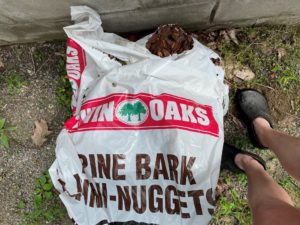Hello, fellow lovers of all things green. Today’s topic hits close to home. Sandy from Sparta, NJ, wrote, “Brian bought pine bark nuggets to mulch the garden, and there are tons of huge black ants and some termites in it. What do I do?”
The close-to-home part is that I’m tackling carpenter ants that nested in the screened porch, so Sandy’s dilemma is my dilemma, too.
 I replied, “Oh my, Sandy, if you already spread the mulch, sprinkling it with diatomaceous earth should work well to kill both critters. But I’ll learn more about what to do about carpenter ants and termites in mulch—I feel a column coming on.”
I replied, “Oh my, Sandy, if you already spread the mulch, sprinkling it with diatomaceous earth should work well to kill both critters. But I’ll learn more about what to do about carpenter ants and termites in mulch—I feel a column coming on.”
Natural Remedies for Carpenter Ants and Termites in Mulch
Diatomaceous Earth (DE) is the fossilized remains of microscopic oceanic plants that destroy the waxy exoskeletons of bugs such as ants, termites, bed bugs, and fleas. Yet DE is safe for people and pets, so much so that it is used in grain-based foods to keep bugs from eating them.
According to the Journal of Agricultural and Food Chemistry, oils such as clove bud and garlic are effective against termites. In addition, the U.S. Forest Service finds tea tree oil highly effective. You can apply the oil at full strength to the wood. Or, mix four drops per gallon of water and spray it, increasing the amount of oil if needed.
Then there’s readily available cedarwood oil. The only thing is that cedar oil can burn foliage, so be sure only to spray it on the mulch. A side note: Cedar oil used as a spray kills ticks on contact; it’s what professional tick prevention services use to treat lawns.
My go-to Neem Oil is another remedy Sandy could use on her mulch. First, mix half a teaspoon of liquid soap in four cups of water, then one teaspoon of Neem Oil. The mixture breaks down in eight hours, so use it right away.
Evidence of Carpenter Ants versus Termites?
A pile of sawdust in the corner behind a potted plant caught our attention and clued us into our dilemma. Termites make small holes in wood and toss their frass (excrements), which look much like sawdust. The same is true of carpenter ants. So, on with the investigator hat to learn which invader we have.
Carpenter ant frass contains ant parts they toss in mounds near the holes. There are no insect parts in termite frass that are uniformly rounded and often scattered rather than mounded around their entry points.
Remedies for Carpenter Ants and Termites Inside your Home
You can DIY by mixing one part of natural dish soap with two parts of water and applying it using a sprayer. So I devised the idea of boiling pots of water, a remedy dear old mom used to kill ants, and mixed the prescribed dish detergent. But when I vacuumed up the frass to find the entry holes, they were on the side of the wood molding, too high to get the boiled water into them. Dang.
A half-cup of white vinegar mixed with a half-cup of lemon juice can also work, though it changes soil acidity, negatively affecting plants. But spraying into the holes is likely a good idea for my dilemma on the porch. Or is there a way to somehow siphon it into the holes with a small hose to kill the trespassers? Hey, I’m growing desperate.
They suggest repeating the process a few times and then seeing if it’s effective. If frass reappears, it didn’t work, so call an exterminator.
It made me think of Groundhog Day
The story has a funny (or maybe not so funny) preamble before finding our intruders. First, I noticed a single black ant, a sizeable one, climbing the wall in front of my writing spot. Then, each morning about the same time, one came trailing by in the same place.
It made me think of Groundhog Day; every day, the same event unfolded at the same time. I knew it wasn’t the same ant, though. Unlike most insects that I release back into the wild, my concern over the invasion took over my empathy.
The single ants were worker carpenter ants looking for other places to nest. Then, they leave pheromone signals to call in their buddies. It’s interesting how we have selective compassion for uninvited guests. Yet, I admire how ant colonies work as a team, but please stay clear of the screen porch.
Garden Dilemmas? AskMaryStone@gmail.com (and your favorite Podcast App).
Enjoy the 8-minute audio version of the story in the Garden Dilemmas Podcast:
Enjoy a related story – Admiration for Ants & Safe Remedies
Link to the Journal of Agricultural and Food Chemistry abstract about clove bud and garlic oils.





